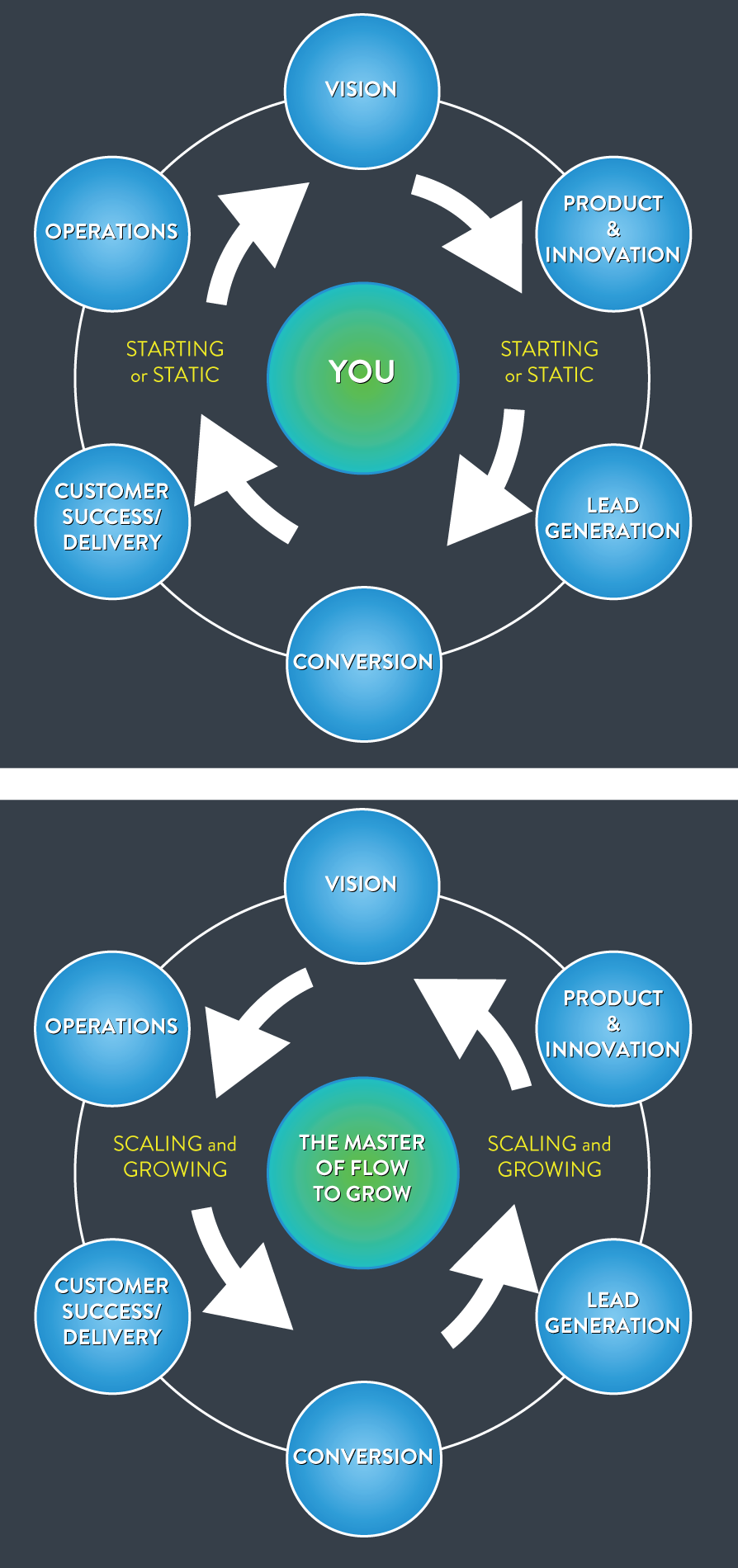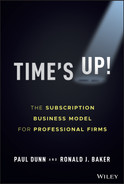7
The Ongoing Upward Spiral—Perhaps a Different Kind of Legacy
If ever you've been involved in helping your customers move forward in any way (some might call that consulting or advisory), you'll be aware that there's a classical five‐step model to do it.
It looks like Figure 7.1 (there's one key difference here, which we'll come to in a moment).
It's simple and logical.
Step 1: You show your customer (or ask potential ones) where they're at right now. And you could do that by focusing on some key numbers like revenue, profit, and so on. But it's much more important (at least initially) to talk about the potential customer's feelings about their current situation. And as you do that, remember to ask a question based on Tamsin Wooley‐Barker's great observation: “Nature doesn't look for problems, it looks for potential.”
That is precisely the point of Step 2: Ask questions about where they could get to, where they want to go, etc. You reframe “problems” into “potentials” as in: “I understand that's an issue right now, Sally. If everything was running right in that area, what's the potential we could unlock here, and what do you feel would be the impact of that?”
Potential really is so powerful, isn't it?
As you note all of those details, you move gracefully to Step 3 by asking “What shifts do you think we need to make to make that possible?”
Step 4 is the transformation—creating a plan of action to make it all happen. This leads you to Step 5, measuring and monitoring performance to plan.
Now we said a few moments ago that the diagram is quite different than the normal one. Here's why: Normally it is shown as a circle that you keep moving around.

FIGURE 7.1 The usual consultancy questioning sequence.

FIGURE 7.2 The upward spiral model.
But it's not a circle—it's an upward rotating and expanding spiral like Figure 7.2.
As you continue to move up the spiral with your customers, it's important to develop rituals, habits, and processes to keep it moving.
One very simple way of doing that is to always have a predefined agenda for each regular (let's say monthly) meeting you or (more importantly) your team have with your members/customers.
By the way, that “members/customers” phrase was not a slip of my fingers on the keyboard. Like every other phrase in this book, it has intent. Here's a personal example:
That's a great upward spiral, isn't it?
So now, let's get back to habits and rituals that lock it all in for you because of the process you have in your meetings with your members (let's just go with that phrasing/naming for now to see how it feels to you moving forward).
And we'd strongly suggest that this becomes part of your “This Is How We Do It Here” processes.
Labeling plays a huge part in this. So don't have agendas, have moving forward plans. My close friend Dr. David Dugan of Abundance Global uses what he calls RAP Sheets, where RAP stands for Review, Align, Plan. It's a really nice sequence.
Whatever you call them, here's a recommended sequence:
It's simple—deceptively simple, in fact. What it does is give you and your Member a firm structure moving forward.
When people see structures, whether it's in meetings or in buildings, they see certainty. It's these structures and processes that create your “This Is How We Do It Here” playbook.
In a very real sense, everything we've written here is not just about getting a brand‐new playbook, it's about getting a brand‐new way of thinking, a way of thinking that leads to a way of behavior that leads to an upward spiral for you and your customers.
This upward expanding spiral is exactly what we'd like you to see as the outcome of your investment in this book and the multiplicity of ideas in it that you've worked your way through.
You applying those insights and ideas gets you started on a fascinating journey.
And what a journey it is—one where you really do enrich your life and the lives of people whom you serve.
That's all about creating the new story we spoke about in Chapter 2—setting the vision, the values, and the agenda for an entire generation yet to come.
That simple realization gets you thinking on other dimensions too—for example, it may well get you thinking about what you leave behind—your legacy, if you will.
Interestingly, when most people think of legacy, they think of it as “leaving a legacy.” So let's pause and make the point that you are going to leave one—we have no choice in that at all.
We are only able to choose what type of legacy it is. And much as I don't like binary choices, this one does come down to this: Is it a legacy of consumption or contribution? Simple as that.
But there's more to it than that, too. You'll know from previous examples in our book that I like alliteration—a string of (typically) three words that begin with the same letter or have the same sound.
So when I started thinking about legacy that way, I realized there was a perfect alliteration like this:
| Living Your Legacy. .………………. | Leveraging Your Legacy . .. .…………. . | Leaving Your Legacy |
Why not live it every day—for example, Embedding Social Good?
Why not leverage our legacy by inspiring others with our story?
And when you think that way, your legacy becomes bigger than perhaps you've ever imagined.
With that in mind, you may remember right at the start we mentioned this quote from Barry Melancon:
We won't recognize the profession in five years. The change is going to be phenomenal going forward.
Time's UP thinking about it. The time is now to do it. As the Chinese proverb reminds us: “The best time to plant a tree was 20 years ago. The second best time is now.”
And doing it—actually getting that tree planted as it were, requires you to see what it might look like.
Remember the diagrams we introduced you to in Chapter 4. You first move clockwise, starting with vision (Figure 7.3). And it starts with you actually not just seeing it but seeing it with total clarity. Once you have that, you need to get your team fully involved.

FIGURE 7.3 Driving the Six Engine Rooms.
We've already spoken about vision. Let's see how it translates into reality (a tough reality at that). Our colleague Ric Payne showed us an interesting exercise many years ago—it's still relevant today.
Here's what John Kotter had to say about the exercise:
I am sometimes amazed at how many people try to transform organizations using methods that look like the first two scenarios: authoritarian decree and micro‐management. Both approaches have been applied widely in enterprises over the last century, but mostly for maintaining existing systems, not transforming those systems into something better.
When the goal is behavior change, unless the boss is extremely powerful, authoritarian decree often works poorly even in simple situations, like the apple tree case. Increasingly, in complex organizations, this approach doesn't work at all. Without the power of kings and queens behind it, authoritarianism is unlikely to break through all the forces of resistance. People will ignore you or pretend to cooperate while doing everything possible to undermine your efforts.
Micro‐management tries to get around this problem by specifying what employees should do in detail and then monitoring compliance. This tactic can break through some of the barriers to change, but in an increasingly unacceptable amount of time. Because the creation and communication of detailed plans is deadly slow, the change produced this way tends to be highly incremental.
Only the approach used in the third scenario above has the potential to break through all the forces that support the status quo and to encourage the kind of dramatic shifts found in successful transformations. This approach is based on vision—a central component of all great leadership. (Kotter 2012, pp. 67–68)
With that in mind, here are nine key steps to make it happen.
NINE STEPS TO TRANSFORMATION
Step 1—Establish a Sense of Urgency
We believe that when you do that, when you examine the marketplace and competitive realities, when you look at the potentials and the risk of not moving, you'll decide that the only time is now.
Step 2—Form a Powerful Guiding Coalition
It's tough to do this stuff alone. You need to assemble a group with enough power and commitment to lead the change. And you need to encourage the group to work together as a team
Step 3—Get On Purpose
Define a North Star—something bigger than you. Remember the website we showed you in Chapter 3—”We're doing this SO THAT WE CAN …”
Again, when you're really clear on your purpose, when it's what you stand for, when it's front and center of everything, when everyone on your team lives and breathes it, then in that moment what you do becomes profoundly more attractive and compelling and you're on the path to stand out.
Step 4—Create a Compelling Vision
Wrap your purpose into a more detailed vision—a vision that inspires, a vision that then flows into very specific strategies moving forward now.
Step 5—Communicate the Vision … Constantly
Use every possible means to articulate the vision—Figure 7.4 shows some examples of posters I've seen in firms' offices (and as background images on Zoom calls).
Of course, you must teach the new behaviors by example.
Step 6—Empower Others to Act on It
It's critically important that you get rid of obstacles to change and that you change any system or structure that undermines the vision. It's crucial, too, to actively encourage risk‐taking and nontraditional ideas, activities, and actions.

FIGURE 7.4 Great‐looking wall posters.
Step 7—Plan for and Create Short‐Term Wins
You must define and engineer visible performance improvements. By define we mean you're going to set targets like “we're going to complete this by …” And make this timeline as short as you possibly can. And then, of course, you recognize and reward team members involved in the improvements.
Step 8—Consolidate and Produce More Change
It's important that you use the increased credibility you and your team get from early wins to keep on changing things that no longer fit the vision. That spills over, of course, into your hiring and promotion processes—you must hire, promote, and develop team members who can implement the vision. Be really clear too on the need to reinvigorate the change process with new projects, themes, and change agents.
Step 9—Institutionalize the New Approaches
All through the change process—the transformation process—make sure you're articulating the links between the new connections and your ongoing success. You need to put systems and processes in place to create and support leadership development and success consistent with the new behaviors.
Tick off these steps each week—they become a key to you committing to the process. Consider each step as a milestone along the way.
This really is the start of an inspiring adventure.
Thank you for starting this journey to a new business model with me. You know there's much, much more to come with Ron. He is going to take you passionately deeper.
Make sure you enjoy the journey ahead with Ron.
And then, of course, you'll be ready to continue your own journey.
From what you know already, that's one that's bursting with potential—potential for you, for your team, and, of course, your customers—every second, every day and in every way.
